In today’s fast-paced digital landscape, cyber threats no longer creep in slowly — they strike and disappear in seconds. For security teams, time is not just a resource; it’s the lifeline that separates containment from compromise.
Yet, most Security Operations Centers (SOCs) still rely heavily on manual workflows. Analysts sift through thousands of alerts daily, review logs from disparate tools, and respond to incidents one by one. The result: alert fatigue, delayed responses, and ever-growing risk exposure.
To break this cycle, Palo Alto Networks introduced a major leap forward — the evolution from Cortex XDR to Cortex XSIAM — marking the next phase in SOC modernization driven by AI and automation.
From Visibility to Intelligence: The Foundation of Cortex XDR
When it was first introduced, Cortex XDR (Extended Detection and Response) redefined threat detection and response. It broke down data silos by integrating telemetry from endpoints, networks, and cloud environments into a unified platform.
By leveraging behavioral analytics and artificial intelligence (AI), XDR delivered three core advantages:
- Complete visibility across the entire infrastructure — from devices to cloud.
- More accurate threat detection, identifying anomalies in user and system behavior.
- Coordinated, rapid response through a single central console.
This approach reduced alert noise by up to 98% and cut investigation time by 88%, establishing a solid foundation for a modern, integrated, and adaptive SOC.
The Next Leap: Cortex XSIAM and Autonomous Security Operations
If XDR is the eyes and ears of the SOC, Cortex XSIAM (Extended Security Intelligence and Automation Management) is the brain.
XSIAM expands on XDR’s capabilities by unifying the entire security ecosystem — including SIEM, SOAR, ASM, ITDR, and EPP — into one AI-driven architecture. This is where autonomous security operations come to life.
With a fully automated design, XSIAM can:
- Aggregate and correlate security data from all sources in real-time.
- Execute automated responses based on trained AI models — without human intervention.
- Continuously learn to recognize new threat patterns.
The outcome: SOCs no longer merely react to threats — they predict, prevent, and remediate them autonomously.
XDR vs XSIAM: From Unified Response to Autonomous Defense
| Aspect | Cortex XDR | Cortex XSIAM |
| Focus | Detection & Response | Autonomous Security Operations |
| Data Sources | Endpoint, Network, Cloud | All SOC components (SIEM, ASM, ITDR, EPP) |
| Automation | Partial | Full and Adaptive |
| AI Capability | Behavioral Analytics | Self-learning & Decision-making |
| Integration | Cross-layer Security | Centralized Single Platform |
| Objective | Incident Handling | Threat Prediction & Prevention |
In short, Cortex XDR enables the SOC to see and act faster, while Cortex XSIAM empowers it to think and respond on its own. This evolution transforms the SOC from a reactive command center into a self-healing, predictive, and adaptive defense system.
How Cortex XSIAM Works?
At its core, Cortex XSIAM starts with one simple ingredient: data. The platform collects raw telemetry from firewalls, endpoints, cloud services, and multiple other sources. AI then pieces together what may seem like random events into a single, fully contextualized incident.
Its operational workflow includes:
- Data collection and integration from all security sources.
- Automated analysis using machine learning models.
- Automated response actions, such as endpoint isolation or IP blocking.
- Continuous learning, enabling the system to evolve and grow smarter over time.
This approach drastically shortens detection and response times — allowing SOC teams to focus on strategy and prevention instead of repetitive manual tasks.
Key Features: AI-Powered Security Operations
1. Unified SOC Capabilities
All core SOC functions, from SIEM, SOAR, XDR, ASM, ITDR, and EPP to Email Security, are now connected within a single integrated platform. Everything can be managed from one console without switching between systems.
2. Automated Operations
Manual processes like enrichment, analysis, and remediation are fully automated through native automation and built-in playbooks.
3. AI-Driven Threat Detection
Pre-trained AI models consolidate hundreds of random alerts into meaningful, high-confidence incidents.
4. Comprehensive Visibility
Delivers a 360° view across all assets — endpoints, identities, networks, and cloud workloads.
5. Proactive Threat Hunting
Contextual data and predictive analytics enable SOC teams to uncover hidden threats before they strike.
6. Cortex Agentic Assistant
Built on Cortex AgentiX, this feature brings intelligent AI that helps security analysts work more efficiently through automation and faster decision-making.
Business Impact: Smarter, Faster, and Resilient SOC
SOC modernization is more than a technology upgrade — it’s a strategic investment. With Cortex XSIAM, organizations can:
- Increase efficiency through full automation.
- Reduce SOC operating costs via platform consolidation.
- Improve detection accuracy and accelerate response time.
- Build adaptive cyber resilience against evolving threats.
The result: a SOC that’s not just reactive, but proactive, intelligent, and outcome-driven.
Virtus Technology Indonesia: Your Partner for the Future SOC
As an authorized distributor Palo Alto Networks in Indonesia, Virtus Technology Indonesia (VTI) plays a pivotal role in helping enterprises embrace AI-powered and fully automated SOC modernization.
Backed by certified technical expertise and deep enterprise security experience, Virtus ensures a seamless transition from Cortex XDR to Cortex XSIAM — delivering measurable results in security, efficiency, and ROI.
Build your future-ready SOC today. Contact Virtus Technology Indonesia to begin your journey toward autonomous security operations with Palo Alto Cortex XSIAM.
Author: Ary Adianto
Content Writer, CTI Group

